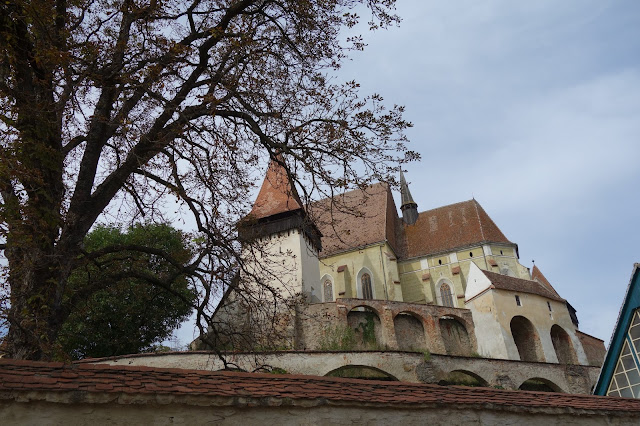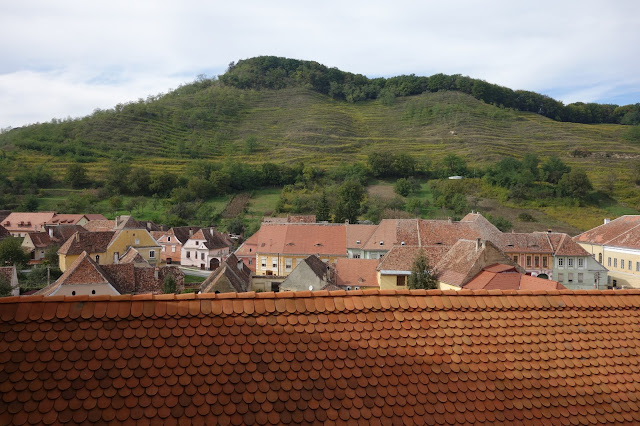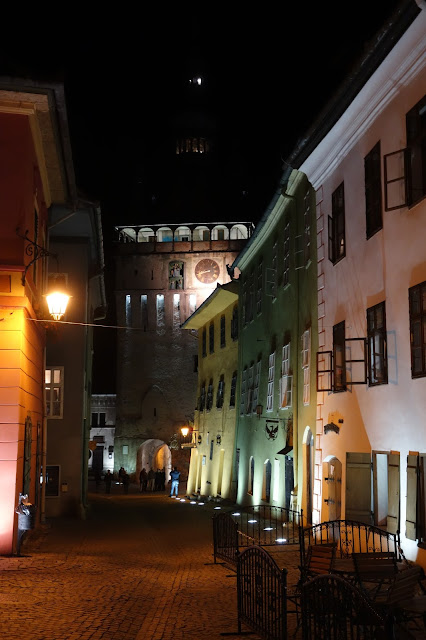Sibiu or Hermannstadt in Transylvanian Saxon dialect is a city in Transylvania, Romania. Formerly the centre of the Transylvanian Saxons, Sibiu was the most important ethnic German city among the seven cities that gave Transylvania its German name Siebenbürgen, literally "seven cities." After World War I, when Austria-Hungary was dissolved, Sibiu became part of Romania. Until 1941 the majority of its population was still ethnic German. Then, from the 1950s until after 1990, most of the city's ethnic Germans emigrated to Germany and Austria. (condensed from wikipedia)
and here was the photo of the town plan- which showed the walls and the two main squares-
here are some photos of our walk around town-
you can see on this side of town the streets slope down to the river-
an open air market occupies the main square and it included something you would NEVER see in the US- a rack of fur coats just open to the public... guess PETA hasn't found out about this yet....
the coats was so luxurious - you can't help your self from touching them but also from feeling bad that some animal died to provide the material - especially when we have more efficient ways of keeping ourselves warm these days- we don't live in caves anymore....
on the way out of town we passed the local synagogue- and another huge open air market that caused a horrific traffic jam... it was Sunday...
we went on to a town called Biertan which was located in an area with a heavy gypsy population... so we passed a lot of gypsy homes and a number of stands with metal pots and utensils for sale.
Biertan is a commune in central Romania and is also one of the most important Saxon villages with fortified churches in Transylvania, having been on the list of UNESCO World Heritage Sites since 1993. The Biertan fortified church was the See of the Lutheran Evangelical Bishop in Transylvania between 1572 and 1867. The commune is composed of three villages: Biertan, Copșa Mare and Richiș, each of which has a fortified church.
The Biertan fortified church is a Lutheran fortified church in Biertan, Sibiu County, in the Transylvania region of Romania. It was built by the ethnic German Transylvanian Saxon community at a time when the area belonged to the Kingdom of Hungary. Briefly Roman Catholic, it became Lutheran following the Reformation. Together with the surrounding village, the church forms part of the villages with fortified churches in Transylvania UNESCO World Heritage Site.
we had lunch in the courtyard of a local restaurant right at the foot of the hilltop church- the weather has remained temperate so we continue to eat outside whenever we can... after lunch we walked around the hill where the church was located and then took the covered steps up to the church-
A hall church with three naves that retains a design close to the original, it was the last such church built in Transylvania, and was constructed between 1486 and 1524 on the site of an earlier Romanesque church. Dedicated to the Virgin Mary and built in Late Gothic style with Renaissance touches, the structure was constrained by the hilly landscape. The choir is 18 meters in length, with a rib-vaulted ceiling, while the three naves of equal height also have rib vaulting. A defensive level above the choir has parapets and a battlement.
The King granted the town the right to bear arms when the Ottoman army was frightening the surroundings. The Transylvanian Saxons instead chose to build of fortresses around the towns, to fortify the churches. The church has three rows of exterior fortifications linked by gate towers. The first, with four towers, dates to the 14th century; the second was built together with the church, and has a series of reinforcing arches; the third, also with towers, is from the 16th and 17th centuries. The clock tower to the north of the church also serves as a gate within the inner fortifications. The clock is above the pyramid-shaped roof.
here is an excellent plan of the entire church fort- from the Internet-
The polyptych altarpiece has 28 panels executed between 1482 and 1513 by a painter likely trained at Vienna and Nuremberg.
The richly decorated intarsia door of the sacristy has a complex lock, displayed at the 1889 Paris World's Fair. Its central system blocks the door in thirteen points, ensuring the safety of the valuables kept in the sacristy.
the interior has a number of pews decorated in by the various guilds- some of which are quite obvious - others are more subtle
carpenters-
shoemakers-
views from the top of the hill and the church yard-
The grounds contain a "matrimonial prison" where couples wishing to divorce were confined so they could be sure they wished to end their marriage. The lockup lasted for two weeks, although the pair could leave early if they reconciled. They had to share a single bed, plate and spoon. During the three centuries that bishops resided at Biertan, just one couple ended up divorcing.
a covered stairway runs along the wall of the fortress up to the church yard on top of the hill-
Since 1990, Saxons come annually to Biertan to celebrate their heritage. In 1993, Biertan and its fortified church were declared a UNESCO World Heritage Site; it was joined by six other places in 1999 to form the villages with fortified churches in Transylvania site. (all blue font is from wikipedia)
from here we headed back on the road and to Sighisoara- we arrived around 4PM and went directly to a brandy tasting in the old town. Phil liked a few of them I only liked one which really was more of a berry liqueur...
this is the town most associated with Vlad the Impaler (alleged Dracula model) because he was born here- so there are a lot of tacky souvenirs with the whole Dracula/Vlad theme-
by now it is nearing 5:30 PM and so we check into our hotel the Binder Bubi (no kidding) and our very nice room overlooks the old city on the hill. We make plans to meet for dinner and return to the old town for a mediocre meal (tourist area) which we bravely ate outdoors (night time temps falling now..)
as we drive back to the hotel - there is a beautiful view of the clock tower from below the old town and so we stop for a photo-
tomorrow we do a morning walking tour of Sighisoara and then on to Gura Humorului... another name that just rolls off the tongue -LOL we will be deep into the territory of the painted monasteries and so will have a lot of amazing photos of those that have survived the travail of centuries of weather... stay tuned!




























































No comments:
Post a Comment